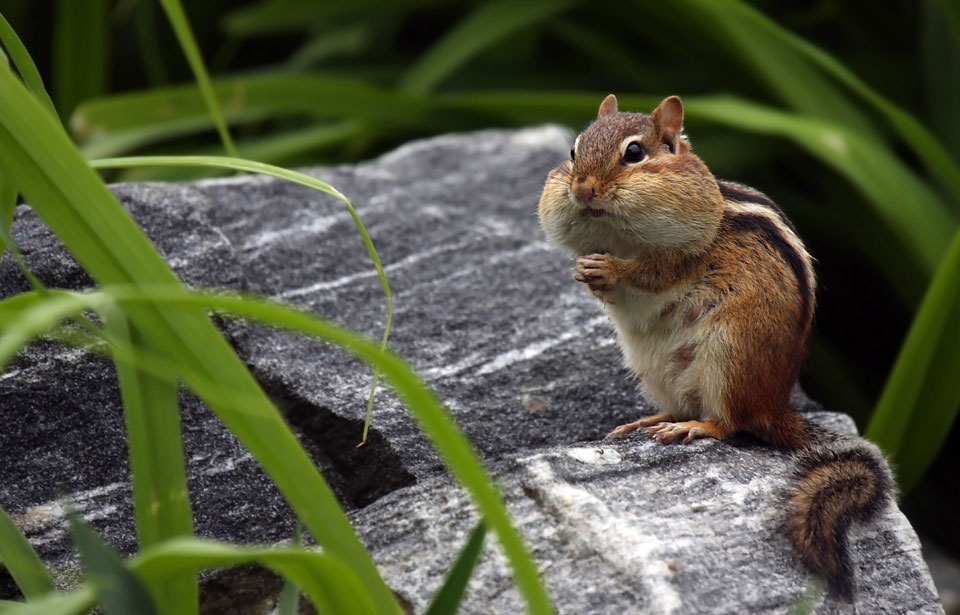An easy way to shelter an array of wildlife is to turn rocks and woody debris into microhabitats. Creatures will appreciate these handy hiding places just about anywhere (near a feeder, for example). They will enable small birds and mammals to flee for cover. Reptiles and mammals may even make nests or dens in these hide-outs.
Transform garden waste into brush piles
Recycle woody debris, such as fallen branches and clippings from pruned shrubs and trees, to create shelter for songbirds. Brush piles not only provide year-round cover for birds, they also are excellent nesting sites for small mammals and invertebrates.
- To build a brush pile with optimum value for birds, select eight or so untrimmed branches about 2 m long.
- Arrange the branches in a teepee-like framework, with butt-ends anchored in the ground and tips interlocking. The idea is to create an internal space where occupants can perch safely off the ground.
- Pile evergreen boughs on the top and sides of this framework to form a dome.
- For added benefit, train climbing vines, such as Virginia creeper, scarlet runner bean, or honeysuckle, onto the brush pile during planting season.
- Each year, add a few new boughs. Leftover corn stalks will make a welcome addition to the brush pile in the fall.
Build Rock Piles
Sunbathing reptiles and amphibians will make good use of a rock pile at a pond’s edge.
- Simply build a mound of rocks and stones of different shapes and sizes, arranging the rock pile in a way that creates openings for shelter and nesting sites.
- Pieces of chimney tile or lengths of pipe at the base will make handy tunnels.
- Add some flat rocks on top for sunbathers.
- Check the site regularly to see if new rocks need to be added to the pile.
Make a Log Pile Habitat
A simple log pile habitat is an easy way to attract a diversity of wildlife to your project site. It’s also a good project to take on if space is limited, but will fit in nicely just about anywhere. You’ll be surprised at how many species this simple habitat attracts. Snails, slugs, toads, and an assortment of other creatures will use the nooks and crannies as hide-outs. Fungus will eventually grow on some of the logs. Spiders will make webs, small mammals like voles may nest among the logs, and birds will come hunting for insects. Small creeping critters like isopods will find food under the moist bark, logs, and leaves. Commonly mistaken for insects, they are actually crustaceans and are related to lobster and shrimp. These harmless creatures (sometimes called sow bugs, wood lice, or roly-polies) do invaluable work. Like earthworms, they chew up rotting plant matter and enrich the soil with their excretions. One type of isopod spends its whole life eating ant larvae.
- Choose a protected spot — under a tree, against a building, beside a fence or wall, or at the edge of a wooded area.
- Spread bark chips on the ground where your logs will be. Make the habitat as big or as small as you like.
- Find recently felled or cut logs of varying lengths from different types of trees. Then arrange the logs — mostly on end, with a few lying lengthwise — with taller logs at the back.
- Anchor the logs with a stake or by planting the vertical ones in the ground so they can’t be tipped over.
- Place flower pots, bricks, rocks, and lengths of pipe amongst the logs to provide hiding spots and passageways. Leave spaces of different sizes between the various odds and ends.
- Put a small pile of twigs and a heap of leaves beside the logs.
- Disturb the log pile habitat as little as possible. If necessary, add material from time to time.
Protect a Fallen Log Habitat
Generally speaking, we love to get out the axe and chain-saw whenever we spot a dying or fallen tree. If a tree in your community is dying and must be removed, try to save at least part of it for wildlife. A length of fallen trunk on the ground creates a wonderful wildlife home. In time, it will transform into a new type of habitat. As it rots, the trunk will become damp and spongy. Mushrooms will appear, and animals like snakes and salamanders will lay their eggs in the moist wood. Beetles and ants will burrow under the bark or lay eggs. A decaying log is a paradise for toads, moles, shrews, and a lot of other creatures, thanks to all the bugs they find there. You can start a mini nature sanctuary simply by leaving a length of tree-trunk lying on the ground. Relax! Let nature do the work.



